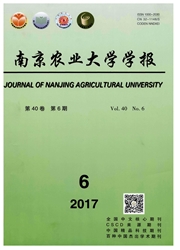

 中文摘要:
中文摘要:
选用长期定位水稻旱作试验土壤,通过盆栽试验研究了不同水稻旱作方式对后作大麦产量、产量构成及养分累积的影响。结果表明:水稻旱作均较水作有利于后作大麦的生长;水稻旱作的后作大麦株高均高于水作后作大麦,产量及其构成也均优于水作后作大麦;在不同水稻旱作方式中,水稻盖草旱作后作大麦的冬前分蘖发生早,每穗粒数和千粒重均略高于其他旱作处理,能够获得相对较高的产量,分别较覆膜旱作和水作高10.84%和17.43%。大麦养分累积则表现为:氮累积量各生育阶段均以前茬盖草旱作处理的为最高,在成熟期达到每盆958.85mg,而磷累积量则是生育前期最高,钾累积量则是生育后期最高。
 英文摘要:
英文摘要:
By using the soil from a long-term different aerobic rice cultivation experimental station,a pot experiment was conducted to study the effect of different rice cultivation on post-cultivated barley growth and yield compositions in the rice-barley rotation system.The results showed that,aerobic rice cultivations were benefitial to the post-cultivated barley growth.The height of barley cultivated after rice covered with plastic film(PFB)and straw mulching(SMB)were higher than water-logged rice(WB).In all treatments of aerobic rice cultivations,tillering occurred earlier in SMB,and a higher yield was obtained in this treatment.Barley yield was the maximum in SMB,which was 10.84% and 17.43% higher than in PFB and WB,respectively.The results of nutrients accumulation showed that,compared with other treatments,nitrogen accumulation rate in SMB treatment was the highest during the whole growth stage,and reached 958.85 mg per pot,that phosphorus accumulation rate was higher during the earlier growth stage and that potassium was higher in the later stage than other treatments.
 同期刊论文项目
同期刊论文项目
 同项目期刊论文
同项目期刊论文
 期刊信息
期刊信息
